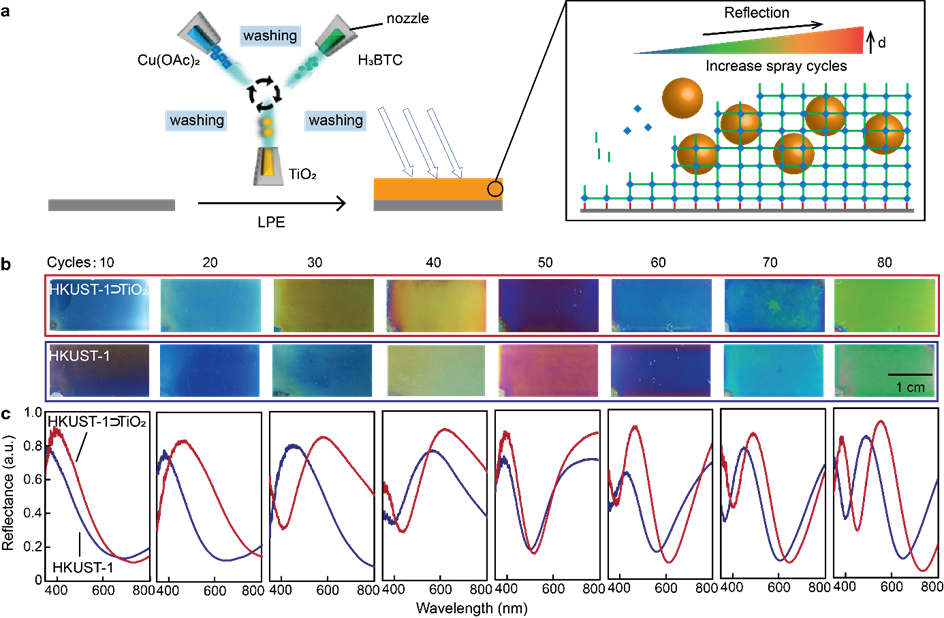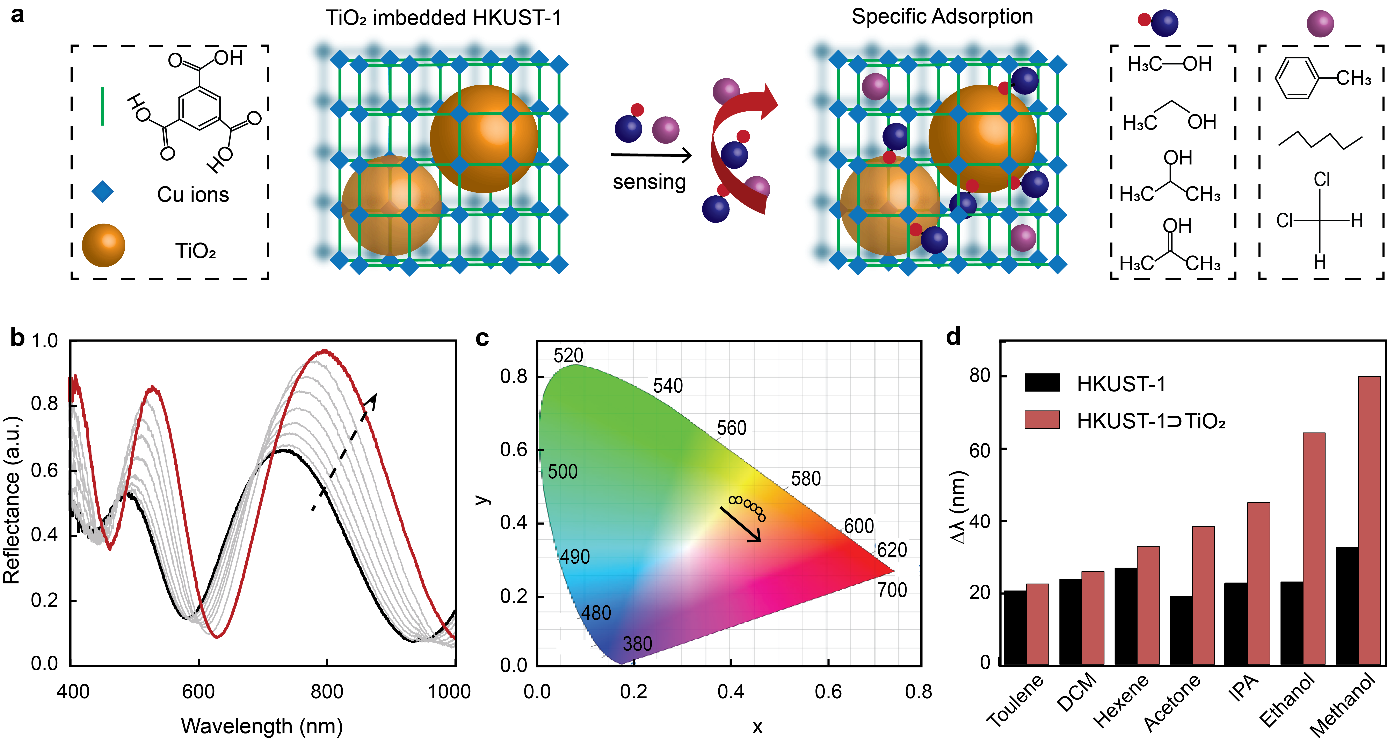Prof. Jianxi Liu's group (State Key Laboratory of Solidifcation Processing, Center of Advanced Lubrication and Seal Materials, School of Materials Science and Engineering, Northwestern Polytechnical University) recently published a paper in Advanced Functional Materials titled "MOFs-based Fabry-Pérot Cavity Encapsulated TiO2 Nanoparticles for Selective Chemical Sensing". In this study, Fabry-Pérot (F-P) cavity constructed by metal-organic frameworks (MOFs) thin film encapsulated TiO2 nanoparticles (NPs) that can achieve selective sensing of chemicals and modulate bandwidth of the cavity (Figure 1).

Figure 1:Tuning reflectance of the MOFs-based F-P cavity by changing the number of spraying cycles for the HKUST-1 and HKUST-1⸧TiO2 films deposition.
F-P cavities are important for recent advances in spectral filters and optical sensor because of their ability to confine electromagnetic fields in a small volume through multiple round-trip reflections. The traditional diaphragm uses inorganic materials or polymers to achieve color filters. Due to the insensitivity of the diaphragm material to the external environment, the F-P cavity is difficult to monitor the variation of the optical path length in real-time, which limits its application in sensing. Consequently, sensitive diaphragms with a thin cavity layer and high specific surface area are crucial for enhancing detection sensitivity of chemicals. MOFs have drawn great attention from both academy and industry because of their unique features, such as high surface area, steerable porous structure, and robust chemical tunability. However, the challenges with existing MOFs for device application are to grow high quality, monolithic thin film that enables hybridization of functional guest species.
They developed an innovative strategy to achieve MOFs-based F-P cavity, and they modulated the bandwidth of the cavity by an optimized liquid phase epitaxy strategy to uniformly encapsulate nanomaterials in high quality MOF thin films. Selectively sensing of analytes were demonstrated on the MOFs-based cavities which attributed to enhanced interaction of the TiO2 and the specific oxygen-containing analytes.
Several highlights of this work include:
(1) Constructed MOFs-based F-P cavity encapsulated well-dispersedTiO2 NPs
Hybrid MOF films embedded with functional guest species have received attractive attention for practical applications on adsorption/separation, catalysis, sensors. The existing method to add functional guest species in MOF films is mostly calcination to obtain homogeneous hybridized films, which often cause the damage of MOFs structures. They developed a sequential spraying coating strategy to encapsulate well-dispersed TiO2 NPs in HKUST-1 thin films (HKUST-1⸧TiO2) by an optimized LPE method.
(2) Manipulated the band width of the MOFs-based F-P cavity controllably
They demonstrated that the band width of the MOFs-based F-P cavity can be tuned over a broad range by adjusting the thickness and refractive index of the HKUST-1⸧TiO2 thin films with controllable TiO2 size and concentration. Using ultraviolet-visible spectroscopy, they showed that the reflection band displayed significant red-shift by increasing the film thickness and the optical color changed due to thickness-dependent optical interference effects. In addition, full-width-at-half-maximum (FWHM) of main reflection band of the HKUST-1⸧TiO2 F-P cavity was narrower and the intensity of reflectance was higher than that of the HKUST-1 layers under the same spraying cycles.
(3) Achieved selective sensing of chemicals on the MOFs-based F-P cavity
They achieved selective chemical sensing on the HKUST-1⸧TiO2 based F-P cavity encapsulated TiO2 NPs. They optimized the cavity configuration in combination of TiO2 NPs into HKUST-1 thin films for the selective sensing evaluation with the rational selection of reflectance change as sensing signals. Accordingly, dynamic sensing result showed that the HKUST-1⸧TiO2 based F-P cavity possessed faster response in comparison to their counterparts configured with only HKUST-1 film. Infrared characterization and Molecule Dynamics simulation proved that encapsulation of TiO2 in HKUST-1 cavity increased the interaction with the analytes via hydrogen bonding (Figure 2).

Figure 2: Chemical sensing on the HKUST-1⸧TiO2 F-P cavity by monitoring the change of reflection.
Prof. Jianxi Liu's group has long engaged in the multifunctional coatings, smart lubrication, nanofabrication, optical sensing. Prof. Jianxi Liu (Northwestern Polytechnical University) and Prof. Feng Zhou (Lanzhou Institute of Chemical Physics, CAS) are the corresponding authors. PhD student Zhihuan Li is the first authors. This research is funded by National Science Foundations, Postdoctoral Science Foundation, Research Fund of the State Key Laboratory of Solidification Processing, Key Research and Development Program of Shaanxi Province, and Guangdong Basic and Applied Basic Research Foundation, and can be viewed by https://onlinelibrary.wiley.com/doi/10.1002/adfm.202109541
Author: Jianxi Liu
Reviewer: Hongqiang Wang,Wei Liu